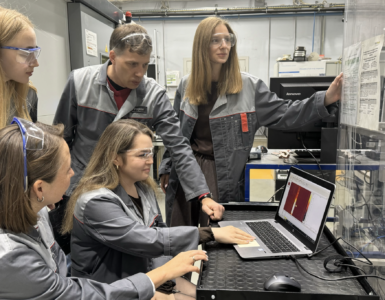Scientists create sponge-like material that could boost nuclear energy and hydrogen technology.
Chemists have developed breakthrough porous materials that could be used for the future of energy, including in the nuclear industry or for storing hydrogen.
The discovery was made by experts from the universities of Southampton and Liverpool.
The new materials, which have sponge-like holes, were developed using powerful computer simulations.
Traditionally, scientists have made similar porous products, known as metal-organic frameworks, or MOFs, using metals linked together with organic molecules.
But the new study, published in Nature, revealed how the materials can be created using only organic salts – which has advantages for production and stability, say the researchers.
Professor of Chemical Modelling Graeme Day, from the University of Southampton, was a co-author of the study.
Graeme Day, said:
We guided the discovery of these materials using a computational method called crystal structure prediction.
“This allows us to predict which non-metal salts will form stable porous frameworks, which salts will not, and to anticipate the precise crystal structure in advance of experimental work.
“We do not have to assume a specific geometry for the joints in the framework, which is a fundamental principle in MOF chemistry.”
More than 95,000 MOFs have so far been discovered – with applications in gas separation and energy storage.
However, metal nodes in MOFs direct the framework structure, rather like joints in a scaffold, according to Professor Day.
He said these joints have a predictable geometry that allows MOFs to be designed for specific applications – and the “molecular Lego” approach does not work for non-metallic salts because the interactions are much less directional.
As part of the study, the Southampton and Liverpool research team used inexpensive and abundant non-metallic elements, such as chloride ion salts, to design the pioneering new material.
According to Prof Day, it has already shown early promise for the capture of iodine, which is important in the nuclear industry,
It could have applications in water capture and hydrogen storage.
Professor Andrew Cooper, from the University of Liverpool, said it was an exciting new development.
Professor Andrew Cooper, said:
Our approach uses non-metal anions as nodes to build frameworks rather than metal cations in MOFs.
“There are more anions available than there are metals in the periodic table, so the space to search for new materials is huge.”
The study can be read in the Nature journal here.
It was funded by the European Research Council, the Leverhulme Trust and the Engineering and Physical Sciences Research Council.
READ the latest news shaping the hydrogen market at Hydrogen Central
Scientists create sponge-like material that could boost nuclear energy and hydrogen technology. source









